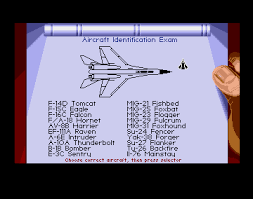Ah ben voilà la source d'inspiration du programme de superchasseur Iranien !
Premier vol d'un démonstrateur du programme NGAD américain !
-
ironclaude
- Légende volante

- Messages : 17329
- Inscription : 18 mai 2006
Re: Premier vol d'un démonstrateur du programme NGAD américain !
#77Non, les iranien ont utilisé la version PC.
Je te suis.
PS : N’empêche, à l'époque, on avait encore de vrai doc.
Je te suis.
PS : N’empêche, à l'époque, on avait encore de vrai doc.
-
warbird2000
- Dieu vivant

- Messages : 23111
- Inscription : 23 mai 2003
Re: Premier vol d'un démonstrateur du programme NGAD américain !
#78Autre article sur le sujet
https://www.scramble.nl/military-news/u ... is-brewing
Pas compris la phrase suivante
https://www.scramble.nl/military-news/u ... is-brewing
Pas compris la phrase suivante
What if the USAF's NGAD demonstrator is really just the jacket/casing of an F-117A Nighthawk".
-
Col. Chibani
- Pilote Confirmé

- Messages : 2680
- Inscription : 07 octobre 2007
Re: Premier vol d'un démonstrateur du programme NGAD américain !
#79J'ai cliqué sur le lien.warbird2000 a écrit : ↑mar. juil. 04, 2023 1:40 pmAutre article sur le sujet
https://www.scramble.nl/military-news/u ... is-brewing
Pas compris la phrase suivante
What if the USAF's NGAD demonstrator is really just the jacket/casing of an F-117A Nighthawk".
Ca n'est pas super clair, mais Scramble se demande si la déclaration comme quoi le premier démonstrateur NGAD a volé, n'est pas à relier aux observations qu'ils ont faites de F-117 portant le badge "Superamus Perstamus Letamus" du NGAD. Leur analyse est que ce F-117 serait l'emballage ("jacket / casing") de systèmes du NGAD.
Dernière modification par Col. Chibani le mar. juil. 04, 2023 2:06 pm, modifié 1 fois.
-
warbird2000
- Dieu vivant

- Messages : 23111
- Inscription : 23 mai 2003
-
warbird2000
- Dieu vivant

- Messages : 23111
- Inscription : 23 mai 2003
Re: Premier vol d'un démonstrateur du programme NGAD américain !
#81Article qui essaie de deviner les futures performances du NGAD
https://www.thedrive.com/the-war-zone/n ... -we-expect
https://www.thedrive.com/the-war-zone/n ... -we-expect
By every account, just as we have been pleading for many years, the manned NGAD aircraft will be optimized for range, payload, and low-observability (stealth), not extreme 'fighter' maneuverability.
Re: Premier vol d'un démonstrateur du programme NGAD américain !
#82Northrop Grumman se retire de la compétition pour se focaliser sur le prochain chasseur de l'USN
https://www.thedrive.com/the-war-zone/n ... ompetition
https://www.thedrive.com/the-war-zone/n ... ompetition
Modern Naval Warfare community manager
Do we have a backup plan?
Yes. Kill everyone on sight.
I like it. Can we make it the main?
Yes. Kill everyone on sight.
I like it. Can we make it the main?
Re: Premier vol d'un démonstrateur du programme NGAD américain !
#83C'était "F-19 Stealth fighter " de Microprose. On pouvait piloter le F-117 ou le F-19. J'avais une préférence pour le F-19 aux commandes plus douces.
Et c'est vrai qu'à l'époque on en avait pour son argent au niveau documentation. Entre la boîte en carton épais, la jaquette, le manuel principal, les cartes des théâtres d'opération, le schéma des touches clavier et les 3 disquettes 3" 1/2
Falcon 4.0 m'a fait retrouver cette ambiance des jeux de simulation des 90's avec cette doc foisonnante.
Re: Premier vol d'un démonstrateur du programme NGAD américain !
#84F-19... il y avait le système anti-piratage qui consistait à reconnaître un avion à partir de l'encyclopédie présente à la fin du manuel (puis sans avec l'érudition aéronautique  ).
).

Microprose savait ajouter une veritable ambiance avec par exemple le café sur la table juste avant le vol et après avec le bar de l'escadrille plus ou moins rempli selon la réussite de la mission et les promotions/médailles obtenues !

Dans Tempête rouge le chasseur furtif donne un avantage non négligeable à l'OTAN en supprimant dès la première nuit la plupart des AWACS soviétiques. C'était l'époque où on imaginait l'avion furtif faire du air-air comme du air-sol (ce qui explique peut-être la présence d'un RIO ?) Les pertes son malgré tout conséquentes et les frisbees ne sortent que de nuit.
 ).
).Microprose savait ajouter une veritable ambiance avec par exemple le café sur la table juste avant le vol et après avec le bar de l'escadrille plus ou moins rempli selon la réussite de la mission et les promotions/médailles obtenues !

Dans Tempête rouge le chasseur furtif donne un avantage non négligeable à l'OTAN en supprimant dès la première nuit la plupart des AWACS soviétiques. C'était l'époque où on imaginait l'avion furtif faire du air-air comme du air-sol (ce qui explique peut-être la présence d'un RIO ?) Les pertes son malgré tout conséquentes et les frisbees ne sortent que de nuit.
Re: Premier vol d'un démonstrateur du programme NGAD américain !
#85'Tempête rouge" sans doute le meilleur livre de Tom Clancy.
A la chasse bordel !!!!!!
Re: Premier vol d'un démonstrateur du programme NGAD américain !
#86Moi, je l'ai trouvé plutôt moyen, trop descriptif mais bon a ce niveau c'est très subjectif hein ?
Re: Premier vol d'un démonstrateur du programme NGAD américain !
#87C'est le style de Tom Clancy, on aime ou on n'aime pas.
A la chasse bordel !!!!!!
Re: Premier vol d'un démonstrateur du programme NGAD américain !
#88Un dessin du NGAD a la fin de la vidéo ?
Modern Naval Warfare community manager
Do we have a backup plan?
Yes. Kill everyone on sight.
I like it. Can we make it the main?
Yes. Kill everyone on sight.
I like it. Can we make it the main?
Re: Premier vol d'un démonstrateur du programme NGAD américain !
#89J'ai comme un doute qu'ils sortent ça si longtemps avant la décision du vainqueur, ne serait-ce que vis-à-vis de la concurrence, nationale (Boeing) ou étrangère (chinoise, russe, ...). Sûrement un "concept art" dans le cadre du programme, ou peut-être même pas (juste pour "faire bien" sur une vidéo de présentation de la société).
Si on se réfère au B-21, quand on voit la tétrach... de dessins sortis tant d'années avant sa présentation et le design réel, on voit qu'il peut y avoir comme qui dirait de sacrées "nuances" entre ces dessins et le vrai B-21.
C'est aussi un peu comme pour le NGF/SCAF. On a une belle maquette pour Le Bourget 2019 et 2023, mais les responsables n'ont pas encore choisi entre les 4 designs restants en lice.
- Pièces jointes
-
- Lockheed Martin NGAD concept.png (265.82 Kio) Consulté 2013 fois
Dernière modification par Deltafan le mar. nov. 21, 2023 12:47 pm, modifié 1 fois.
"Toujours en mouvement est l'avenir…"
Yoda
Yoda
Re: Premier vol d'un démonstrateur du programme NGAD américain !
#90On dirait le petit frère du SR-72 Darkstar
-
warbird2000
- Dieu vivant

- Messages : 23111
- Inscription : 23 mai 2003
Re: Premier vol d'un démonstrateur du programme NGAD américain !
#91dernières nouvelles du ngad
Une cible de 250 avions à produire
deux versions: une pour opérer en europe et une à long rayon d'action pour le pacifique
Cet avion coutera plusieurs centaines de millions de dollars par unité


https://www.airandspaceforces.com/usaf- ... ar-budget/
Une cible de 250 avions à produire
deux versions: une pour opérer en europe et une à long rayon d'action pour le pacifique
Cet avion coutera plusieurs centaines de millions de dollars par unité
https://www.airandspaceforces.com/usaf- ... ar-budget/
Re: Premier vol d'un démonstrateur du programme NGAD américain !
#92Comme les JO ! Plus loin, plus haut, plus fort et surtout plus cher !
Vous avez (budgétairement) aimé la compétition ATF ? Vous avez aimé le F-22 ? Vous avez aimé le F-35 ?
Alors vous allez kiffer le NGAD !
Les chasseurs de 6ème génération, la nouvelle arme absolue... Tu n'as plus besoin de descendre les chasseurs de ton ennemi vu qu'il s'est ruiné à tenter de les développer et de les construire en vain !
Vous avez (budgétairement) aimé la compétition ATF ? Vous avez aimé le F-22 ? Vous avez aimé le F-35 ?
Alors vous allez kiffer le NGAD !
Les chasseurs de 6ème génération, la nouvelle arme absolue... Tu n'as plus besoin de descendre les chasseurs de ton ennemi vu qu'il s'est ruiné à tenter de les développer et de les construire en vain !
Re: Premier vol d'un démonstrateur du programme NGAD américain !
#93Les Chinois vont-ils faire le même coup aux USA que ce que les USA ont fait à l’Union Soviétique pendant la guerre froide ?
Re: Premier vol d'un démonstrateur du programme NGAD américain !
#94Ca fait penser au F117. Ils ont même sorti plusieurs maquettes plastiques avec des formes différentes. Même Buck Danny y a eu droit.
Et tout le monde est tombé sur le cul quand ils les ont dévoilés.
(\_/)
(_'.')
(")_(") "On obtient plus de choses avec un mot gentil et un pistolet qu'avec le mot gentil tout seul" Al Capone.
Mon pit
(_'.')
(")_(") "On obtient plus de choses avec un mot gentil et un pistolet qu'avec le mot gentil tout seul" Al Capone.
Mon pit
Re: Premier vol d'un démonstrateur du programme NGAD américain !
#95C'est zarbi...warbird2000 a écrit : ↑dim. mars 17, 2024 3:25 pmdernières nouvelles du ngad
Une cible de 250 avions à produire
deux versions: une pour opérer en europe et une à long rayon d'action pour le pacifique
Cet avion coutera plusieurs centaines de millions de dollars par unité


https://www.airandspaceforces.com/usaf- ... ar-budget/
Alors qu'il est toujours sans rival, ils ont trouvé le F-22 beaucoup trop cher et n'en ont finalement commandé que 187, avant de dire qu'il coûtait également beaucoup trop cher en entretien. Et maintenant, ils veulent en développer un dont ils savent d'avance qu'il sera encore beaucoup, beaucoup plus cher... (et qui sera donc certainement encore beaucoup, beaucoup plus cher en entretien...)
"Toujours en mouvement est l'avenir…"
Yoda
Yoda
Re: Premier vol d'un démonstrateur du programme NGAD américain !
#96Les F-22 coûtait trop cher pour larguer des JDAM sur des barbus en Irak.Deltafan a écrit : ↑lun. mars 18, 2024 12:47 amC'est zarbi...warbird2000 a écrit : ↑dim. mars 17, 2024 3:25 pmdernières nouvelles du ngad
Une cible de 250 avions à produire
deux versions: une pour opérer en europe et une à long rayon d'action pour le pacifique
Cet avion coutera plusieurs centaines de millions de dollars par unité


https://www.airandspaceforces.com/usaf- ... ar-budget/
Alors qu'il est toujours sans rival, ils ont trouvé le F-22 beaucoup trop cher et n'en ont finalement commandé que 187, avant de dire qu'il coûtait également beaucoup trop cher en entretien. Et maintenant, ils veulent en développer un dont ils savent d'avance qu'il sera encore beaucoup, beaucoup plus cher... (et qui sera donc certainement encore beaucoup, beaucoup plus cher en entretien...)
Maintenant que la Russie et la Chine se font plus menaçantes, ça donne plus de motivation.
Bon, j'attends toujours de voir la gueule NGAD...
Re: Premier vol d'un démonstrateur du programme NGAD américain !
#97Je me rappelle avoir lu un AFM dans les années 90 où ils avaient comparé l'évolution du budget de l'USAF et celui du prix unitaire de ses chasseurs.
Ils en avaient conclus qu'en 2070, les courbes se croiseraient, ie l'USAF n'auraient les moyens de ne s'acheter qu'un seul chasseur.
C'est évidemment plutôt ironique, mais dès qu'on parle du NGAD, je ne peux m'empêcher d'y repenser
Ils en avaient conclus qu'en 2070, les courbes se croiseraient, ie l'USAF n'auraient les moyens de ne s'acheter qu'un seul chasseur.
C'est évidemment plutôt ironique, mais dès qu'on parle du NGAD, je ne peux m'empêcher d'y repenser
Re: Premier vol d'un démonstrateur du programme NGAD américain !
#98Ah, c'est le moment de rappeler la 16e loi d'Augustine (lois qui datent de 1984) : 


In the year 2054, the entire defense budget will purchase just one aircraft. This aircraft will have to be shared by the Air Force and Navy 3-1/2 days each per week except for leap year, when it will be made available to the Marines for the extra day.
-
warbird2000
- Dieu vivant

- Messages : 23111
- Inscription : 23 mai 2003
Re: Premier vol d'un démonstrateur du programme NGAD américain !
#99Cela va faire beaucoup à caser dans un budget
NGAD
F-35
CCA ( le wingman )
F-15EX
B-21
KC-46
On déjà compris que le F-15EX sera sacrifié . Quel sera le suivant ?
NGAD
F-35
CCA ( le wingman )
F-15EX
B-21
KC-46
On déjà compris que le F-15EX sera sacrifié . Quel sera le suivant ?
Re: Premier vol d'un démonstrateur du programme NGAD américain !
#100Le futur réacteur du NGAD (P&W XA-103 ou GE XA-102) sera plus petit que les XA-100 et 101 précédemment envisagés pour remotoriser le F-35. Il devrait commencer à être testé en en vol en 2028, pour un premier vol sur NGAD en 2030.
Article ASF, avec le titre : Air Force Wants $1.3 Billion to Finish Design for New Fighter Engine
https://www.airandspaceforces.com/air-f ... e=sailthru
Article ASF, avec le titre : Air Force Wants $1.3 Billion to Finish Design for New Fighter Engine
https://www.airandspaceforces.com/air-f ... e=sailthru
The Air Force has requested $1.3 billion over the next three years to compete development of a new engine to power the Next-Generation Air Dominance fighter, which will succeed the F-22. The effort, already well underway, picks up where the Adaptive Engine Transition Program left off, and may yield a new powerplant ready for production in the 2028 time period.
(...)
According to budget documents for the “Advanced Engine Development” program element, the Next-Generation Adaptive Propulsion (NGAP) program will “design and perform risk reduction” for adaptive engine prototypes applicable to NGAD, the secretive fighter set to enter flight test around 2028.
(...)
The Air Force said the NGAP effort “consists of six phases: initial design, preliminary design, adaptive prototyping planning, detailed design, engine fabrication, and engine assessments.” Initial and preliminary design activities are already complete, indicating that prototypes are now being sketched out. The Air Force has said that it needs the NGAD to be ready for operational service around 2030, which means its engine, the NGAP, will have to be ready for flight testing at least two years prior. The plan for fiscal 2025 is to “complete NGAP detailed design activities and transition to prototype engine fabrication and assembly activities,” according to budget docs.(...)
The AETP—in the form of GE Aerospace’s XA100 and Pratt & Whitney’s XA101—was designed to fit in the F-35 and would have given that fighter impressive gains in thrust, acceleration, and range. But the Pentagon and the international F-35 partners opted against pursuing it because it could only be applied to the F-35B and C variants with extensive further engineering. Buying the engine only for the Air Force and other countries using the F-35A model would have required creating separate parts, logistics, and maintenance systems, raising costs. (...)
Although little is known about the NGAD, Kendall and John Sneden, head of the Life Cycle Management directorate for propulsion, have said the NGAD engine will be smaller than the AETP engines developed by GE and Pratt, arresting a steady growth in engine fan diameter since the 1970s. But it also means the AETP cannot simply be tweaked to power the NGAD. Instead, a wholly new design is required.
(...)
In February, Pratt said it had completed the critical design review on its NGAP engine, which it said bears the designation XA103. GE Aerospace’s engine is the XA102.
(...)
The NGAD is expected to be a very expensive platform. Kendall has said the aircraft will cost “in the multiple hundreds of millions” of dollars each.
"Toujours en mouvement est l'avenir…"
Yoda
Yoda









